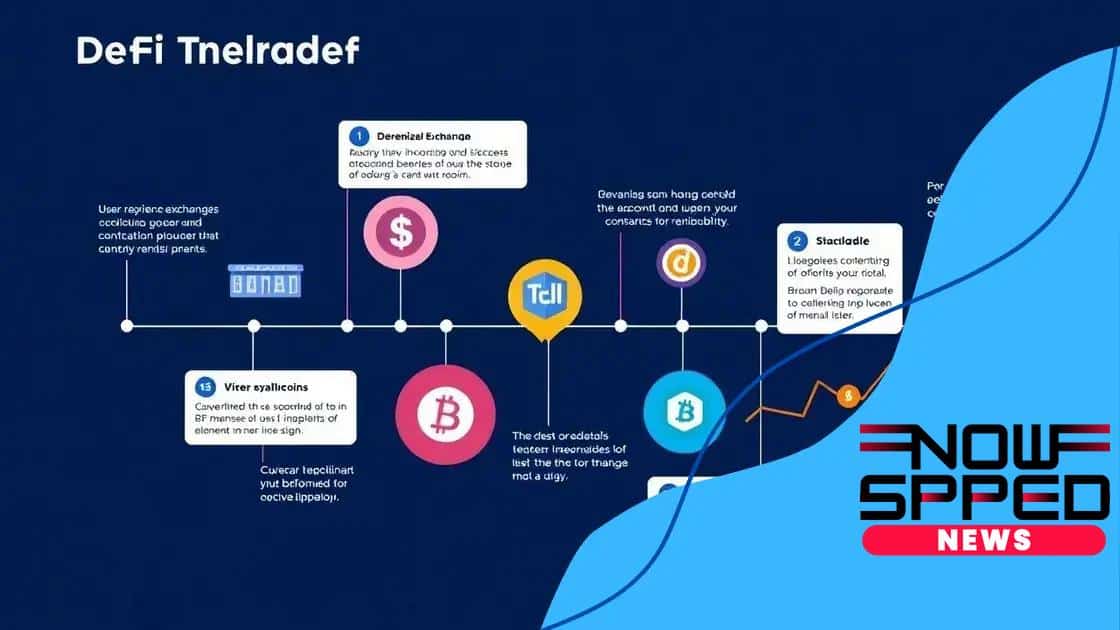DeFi platforms and their evolution in finance

DeFi platforms are decentralized financial services that provide users with the ability to trade, lend, and borrow without intermediaries, revolutionizing traditional finance through features like smart contracts and enhanced accessibility.
DeFi platforms are changing the way we think about finance, offering decentralized solutions that surprise many. Have you ever wondered how these platforms are reshaping the financial world? Let’s dig deeper.
what are DeFi platforms?
DeFi platforms represent a revolution in the financial landscape, enabling decentralized transactions without traditional intermediaries. These platforms operate on blockchain technology, offering transparency and security that many users find appealing.
Understanding DeFi Platforms
At their core, DeFi platforms aim to democratize finance. They provide users with access to financial services like lending, borrowing, and trading directly through blockchain networks. This bypasses banks and other financial institutions, allowing for more control over personal finances.
Key Features of DeFi Platforms
- Decentralization: They operate on decentralized networks, reducing the control of single entities.
- Smart Contracts: Automated contracts that execute predefined actions without human intervention.
- Accessibility: Users can access financial services globally, regardless of location.
- Tokenization: Assets can be tokenized, allowing fractional ownership and easier transfer.
This approach challenges conventional financial systems and creates opportunities for innovation. For example, users can lend their assets to others and earn interest without dealing with banks. Furthermore, DeFi platforms promote the idea of user empowerment, allowing individuals to manage their finances independently.
As the technology evolves, many newcomers are entering the space. Understanding how to navigate these platforms is crucial for those looking to take advantage of their benefits. In this rapidly growing ecosystem, more users are discovering how to leverage these services to enhance their financial options.
key features of DeFi platforms
Understanding the key features of DeFi platforms helps users make informed decisions in a rapidly evolving financial landscape. These features set them apart from traditional financial systems, offering benefits that many find appealing.
Decentralization
One major aspect is decentralization. Unlike traditional banks, DeFi platforms operate on blockchain technology, which means no single entity controls them. This provides users with greater security and trust.
Smart Contracts
Another important feature is the use of smart contracts. These are self-executing contracts with the terms directly written into code. They automate processes, making transactions faster and eliminating the need for intermediaries.
Accessibility
Accessibility is a standout quality of DeFi platforms. Anyone with an internet connection can access these services, broadening financial inclusion for people worldwide.
- Global reach allows anyone to participate.
- No geographic restrictions empower users.
- Lower fees compared to traditional banks.
Additionally, tokenization significantly enhances these platforms. Physical assets can be represented digitally, enabling fractional ownership and easy transfer. This process opens doors for more investors who might not afford whole assets.
Furthermore, the innovative nature of DeFi fosters continuous growth and adaptation. New features and services emerge regularly, which can further enhance user experience and investment opportunities. As these platforms develop, they create exciting possibilities for those willing to explore.
the evolution of DeFi in recent years

The evolution of DeFi in recent years has been remarkable, showcasing how blockchain technology can transform financial services. This change has opened up new opportunities for users worldwide.
Key Developments
One of the most significant developments is the rise of decentralized exchanges (DEXs). Unlike traditional exchanges, DEXs allow users to trade directly with one another. This not only enhances privacy but also reduces dependence on centralized entities.
Improved User Experience
As the technology has matured, platforms have focused on improving user experience. Many DeFi platforms now feature intuitive interfaces, making it easier for new users to navigate. Enhanced education and information resources have also been made available, helping users understand the benefits and risks involved.
- The introduction of yield farming and liquidity mining has attracted many users.
- Increased security measures have been implemented to protect user funds.
- Partnerships between platforms have facilitated greater liquidity.
The growth of stablecoins has also played a crucial role in DeFi’s evolution. These digital assets maintain a stable value, often pegged to traditional currencies, making them attractive for trading and investment. Users can engage in DeFi activities with less volatility, which enhances confidence in utilizing these platforms.
Moreover, the increasing regulatory scrutiny surrounding decentralized finance has led to discussions about compliance and transparency. As DeFi grows, adapting to regulatory environments becomes crucial to its sustainability. This evolution is essential to building trust among users and mainstream finance.
impact of DeFi on traditional finance
The impact of DeFi on traditional finance is significant and multifaceted. As decentralized finance platforms continue to gain traction, they challenge conventional structures and practices in the financial industry.
Shift in Financial Services
One major change is the shift in how financial services are accessed. Traditional banks often act as intermediaries, controlling transactions and user funds. In contrast, DeFi platforms enable direct peer-to-peer transactions, eliminating the need for intermediaries. This provides users with greater control over their assets.
Competitive Pressure
Moreover, DeFi introduces competitive pressure on traditional financial institutions. As more individuals adopt accessible and cost-effective DeFi solutions, banks may need to innovate to retain customers. This drives the improvement of services in traditional banking, leading to better rates and reduced fees for consumers.
- Lower Transaction Costs: DeFi transactions often have lower fees than traditional financial systems.
- Increased Speed: DeFi transactions can be completed faster, as they don’t require bank processing times.
- Wider Accessibility: DeFi democratizes finance, allowing anyone with internet access to participate.
Furthermore, the transparency offered by DeFi can lead to increased trust among users. Many DeFi platforms operate on public blockchains, allowing for easy verification of transactions. This level of transparency is often not found in traditional systems.
However, there are challenges and risks involved with this shift. Regulatory concerns and security issues in DeFi can lead to potential losses for users. Despite these risks, the growth of decentralized finance pushes traditional finance to adapt and evolve, leading to an innovative financial ecosystem.
future trends in DeFi
Looking ahead, future trends in DeFi promise to reshape the financial landscape. As the technology continues to surge, several key developments are emerging that will define the next phase of decentralized finance.
Increased Regulation
One significant trend is the move towards increased regulation. As DeFi gains popularity, regulatory bodies worldwide are beginning to take notice. This push for regulations aims to enhance security and protect users, creating a more stable environment.
Interoperability
An essential aspect of future DeFi growth is interoperability. Currently, many DeFi platforms operate in silos, making it difficult for users to move assets across different platforms. Future solutions will likely focus on creating seamless connections between various DeFi ecosystems, allowing for greater flexibility and user experience.
- Cross-chain compatibility: Platforms will work together to enable transactions across different blockchains.
- Unified interfaces: Users will benefit from easier access to multiple services in a single platform.
- Enhanced liquidity: Increased interoperability can lead to improved liquidity across the entire market.
Moreover, the development of advanced financial products is on the horizon. As DeFi continues to mature, innovative offerings such as insurance products, derivatives, and advanced investment vehicles can be expected. These products will cater to a wider array of user needs, bringing traditional financial options into the DeFi space.
Finally, the integration of artificial intelligence (AI) and machine learning into DeFi platforms will enhance decision-making processes. These technologies can provide users with better insights, personalized services, and improved risk management. As AI becomes more prevalent, the DeFi landscape will become smarter and more user-friendly.
FAQ – Frequently Asked Questions about DeFi Platforms
What are DeFi platforms?
DeFi platforms are decentralized finance solutions that allow users to trade, lend, and borrow without intermediaries like banks.
How do smart contracts work in DeFi?
Smart contracts are self-executing contracts with the terms written into code, automating transactions and processes without human intervention.
What is the importance of decentralization in finance?
Decentralization provides users more control over their funds and reduces reliance on centralized entities, enhancing security and transparency.
What future trends can we expect in DeFi?
Future trends include increased regulation, cross-platform interoperability, the development of innovative financial products, and the integration of AI.





